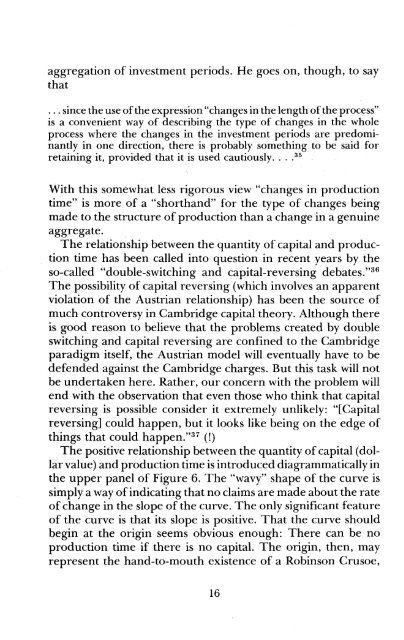Austrian Macroeconomics - Ludwig von Mises Institute
Austrian Macroeconomics - Ludwig von Mises Institute
Austrian Macroeconomics - Ludwig von Mises Institute
You also want an ePaper? Increase the reach of your titles
YUMPU automatically turns print PDFs into web optimized ePapers that Google loves.
aggregation of investment periods. He goes on, though, to say<br />
that<br />
... since the use ofthe expression"changes in the length ofthe process"<br />
is a convenient way of describing the type of changes in the whole<br />
process where the changes in the investment periods are predominantly<br />
in one direction, there is probably something to be said for<br />
retaining it, provided that it is used cautiously....35<br />
With this somewhat less rigorous view "changes in production<br />
time" is more of a "shorthand" for the type of changes being<br />
made to the structure of production than a change in a genuine<br />
aggregate.<br />
The relationship between the quantity of capital and production<br />
time has been called into question in recent years by the<br />
so-called "double-switching and capital-reversing debates."36<br />
The possibility of capital reversing (which involves an apparent<br />
violation of the <strong>Austrian</strong> relationship) has been the source of<br />
much controversy in Cambridge capital theory. Although there<br />
is good reason to believe that the problems created by double<br />
switching and capital reversing are confined to the Cambridge<br />
paradigm itself, the <strong>Austrian</strong> model will eventually have to be<br />
defended against the Cambridge charges. But this task will not<br />
be undertaken here. Rather, our concern with the problem will<br />
end with the observation that even those who think that capital<br />
reversing is possible consider it extremely unlikely: "[Capital<br />
reversing] could happen, but it looks like being on the edge of<br />
things that could happen."37 (!)<br />
The positive relationship between the quantity ofcapital (dollar<br />
value) and production time is introduced diagrammatically in<br />
the upper panel of Figure 6. The "wavy" shape ofthe curve is<br />
simply a way ofindicating that no claims are made about the rate<br />
ofchange in the slope of the curve. The only significant feature<br />
of the curve is that its slope is positive. That the curve should<br />
begin at the origin seems obvious enough: There can be no<br />
production time if there is no capital. The origin, then, may<br />
represent the hand-to-mouth existence of a Robinson Crusoe,<br />
16

















